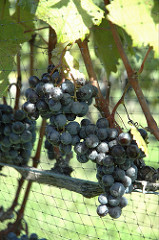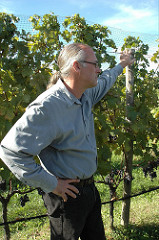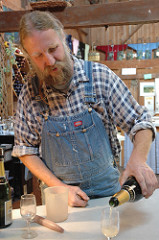The OWF "Eat 'Til You Drop" Tour: Long Island Part 1

Photo by melissa nicole.
In 1973, Louisa Thomas Hargrave and her then-husband Alex thumbed their noses at naysaying wine experts and planted Vitis vinifera vines on the North Fork of Long Island's East End, a lobster claw of land that juts into the Atlantic. Most scientists thought they would fail: Native American V. labrusca flourishes in the area, but they believed vinifera, the foundation of Europe's wines, was too fragile for the cold environment.
Today, thirty-eight wineries are scattered over the East End, a fertile area with small slopes that seem flat to my Bay Area eyes. The Hargraves had found a microclimate that defied common wisdom. On the thin North Fork, home to most of Long Island's wineries, buckets of sunshine pour onto the fertile soil and the surrounding water moderates the temperature to protect fragile vines. In the Hamptons on the South Fork, the few wineries set among the summer homes of the rich and famous contend with the unmitigated chill of the Atlantic, which shortens the growing season by a few weeks. Zander Hargrave, Louisa's son, feels that Cabernet Franc is Long Island's glistening jewel, and many critics agree. Merlot from the area is also well regarded, but growers experiment with a large variety of grapes, albeit with mixed success.
I already knew something about the area because Lenn Thompson's Lenndevours is one of my daily reads. No one else provides such an in-depth look at these shoreline vineyards. But I had never tasted any of the wines. When Louisa, now the Director of Food, Wine, and Culture at Stony Brook University, invited me out to teach a class with Lenn (it got canceled; c'est la vie), Melissa and I spent a couple days exploring local wineries. Louisa graciously invited us to stay with her (I met her at the Wine Writers Symposium, and we hit it off), and Lenn offered to take a day off work to take us to some of his favorite spots.
It was a treat to meet Lenn after reading his site and corresponding with him for so long. Melissa was disappointed he didn't bring Ben, his new beagle. Nena, Lenn's wife, was disappointed she couldn't join us for the day, though she did join us the next evening for dinner.
Of course, with Lenn and Louisa acting as tour guides, we went to the best Long Island has to offer and got treated very well. It didn't make for a well-rounded perspective, but this was supposed to be a vacation and we didn't feel the need to waste time on lesser lights.

David Page from Shinn Estate
Photo by melissa nicole.
Shinn Estate Vineyards
It was an interesting time to visit. Most producers were in the middle of harvest, and they were trying to recover from a torrential nineteen inches of rain over eight days (Beau and Kori from Basic Juice, who visited the week before, battled blocked roads and unpleasant weather; we drove our glaring yellow rental under sunny skies). Though all the white grapes were in before the rain hit, some producers lost half of their unharvested red crop.
Not at Shinn Estate Vineyard. While we visited grape growers David Page and Barbara Shinn, another grower drove up in his truck. "Everyone's going to be coming by asking how we held onto our crop," said Barbara, a friendly, young-looking woman with deep brown hair and a slight Midwestern accent. She and David, a tall man with a graying ponytail, don't have an easy answer to the puzzle. Probably it was a mix of factors, but when they suggest that the lush ground cover in the vineyard might have absorbed excess water, it makes sense.
The vigorous cover crop is one idea David and Barbara take from the biodynamic movement, which involves a holistic, semi-mystical approach to vineyard management. They pick and choose the philosophies that make sense to them—Barbara has a strong background in ecology—but they're not zealous converts. David ruefully admitted that harvest happened on a full moon. "I swore I'd never do that," he said, referring to a practice many biodynamicists follow.
We wandered through the vines, surveying the grapes with David and Barbara. At one point Roman Roth, who makes the Shinn wines from his facility in the South Fork's Wolffer Estate, came by to look over the vines as well. The six of us talked about wine and food and when Roman left the rest of us retired to the tasting room to nibble on New York cheeses, sample the Shinn wines, and talk about David and Barbara's plans for the the winery.
What did the wines taste like? I can't really say. Melissa and I were recovering from colds, and my nose could barely register anything beyond earthy or fruity. We liked the aromas that fought their way to our beleagured olfactory nerves, and I'll write a better tasting note in the future. The taste components—acidity, tannins, and weight—were well balanced. In a blind taste test of Long Island Merlot described in the current Edible East End, a Shinn wine pushed ahead of its peers. We bought several bottles to try later, which Barbara shipped to us (along with, unexpectedly, our acquisitions from other wineries we visited, but that's a post for a different day).

Eric Frye of Lenz Winery
Photo by melissa nicole.
Lenz Winery
Eric Frye, the wine maker for Lenz Winery along with several others on the East End, reminds me of Bonny Doon's Randall Grahm. There are certain physical similarities—both are tall with barely contained ponytails—but the true kinship is in their attitude. Eric is opinionated and disdainful of many in the wine industry, and he doesn't care if you know it. When he heard about my label-celebrating Wine Blogging Wednesday theme, he practically threw me out on the spot. He's earned his attitude: Probably only Louisa predates him in Long Island's wine industry, and he seems to have made wine for everyone on the North Fork.
We caught him midway between incoming grape shipments; his overalls and rubber boots spoke to his busy workload. He led us through the winery and then through our wine tasting. He makes a number of sparkling wines, but his star seems to be the Gewurztraminer. Even our stuffed-up noses noticed the lush aromas erupting from the glass. When we later told people that we had bought a bottle, they all nodded sagely. "Good choice," or "That's the one to get" were common responses.
We liked the sparklers, though in our congested state I couldn't write much in the way of notes other than "pleasant" or "good acidity." He ended our tasting with a Cabernet Sauvignon, urging us to guess the grape before he told us what it was. He wanted us to compare it to California Cab, an exercise in futility. Here we battle raisined fruit and there it struggles to get ripe. Even Eric acknowledges that the variety has a tough time in the East End: Sometimes it doesn't come in until mid-November.
I wish I had been able to fully appreciate Lenz's wines. When a wine maker has such strong opinions, the wine is almost always interesting. Eric clearly feels a minimal need to cater to the masses. He makes a variety of Chardonnays that he hopes will wean people from the oaky, buttery Chardonnays that most Americans buy.

Bottles at Paumanok Vineyards
Photo by melissa nicole.
Paumanok Vineyards
Our final stop on the first day was Paumanok, around the corner from Louisa's house. We followed Lenn in our luminescent rental before he took off: He made some excuse about needing to sign papers for a house or some such. A likely story.
We didn't meet owners Ursula and Charles Massoud, as they were busy with winery matters. But we chatted up the tasting room manager quite a bit, who graduated us to "real wine glasses" once she found out who our friends were. The winery's whites didn't grab me, but I liked their 2001 Grand Vintage Merlot quite a bit.
The next day, we made our way down to the Hamptons. But you'll have to come back later for that.
Technorati tags: food & drink | wine | long island
- Wine On Fridays: Sequoia Grove Winery - A Taste Of Cabernet
A few years ago I wrote a story about Chardonnay and consumers perception of it. It's a wine that while very popular, is also held in disdain by many consumers. Napa Cabernet Sauvignon is another such wine. Not that there is just one Napa...
- Wtn: 2005 Wölffer Estate Rosé, The Hamptons, New York, Usa
Every year in the late spring, wine publications run features that sing the praises of rosé wines. Every year, I wonder if anyone still believes that rosés are off-balance sweet wines in the manner of White Zinfandel. But I was out to dinner...
- Bloggers With Class...
...or class with bloggers. Lenn and I will be leading a discussion about food and wine blogging at Stony Brook University's Center for Wine, Food, and Culture on October 20. We're going to talk about why we do the blog thing, evangelize the medium...
- Sonoma Day Trip #2
Melissa had to meet with a client in Sonoma, and she knew I'd come along if she suggested we go wine tasting afterwards. After her meeting and our lunch at Sonoma Saveurs (always enjoyable, though they recently lost their head chef) we set out for...
- Amador/el Dorado Wines
When we left Tahoe, we decided to swing through Amador and El Dorado counties to try some of the wines of the Sierra foothills. This is a wine region that is off the beaten path, to say the least. Route 16, a winding back-country road, seems to be the...
